Robert the Bruce
(Robert I of Scotland)
1274–1329Robert Bruce was a Scottish nobleman who claimed the throne of Scotland when the death of the Maid of Norway, in 1290, left the throne open. Though disappointed in the election of John Baliol, he at first submitted to Baliol and Edward I, as he was steward of lands in both England and Scotland. When William Wallace raised the cause of Scottish independence, Bruce at first fought against him, on the side of Edward I. After the Battle of Falkirk however, he took up the cause of Scottish independence, but did not at first, break his alliance with Edward I. Baliol was a highly unpopular king, and Bruce hoped that in time, the throne would devolve to himself. As time went on however, it became clear that Edward would never support him as an independent king, and furthermore, there was great intrigue among Scottish nobles in vying for Edward's favor.
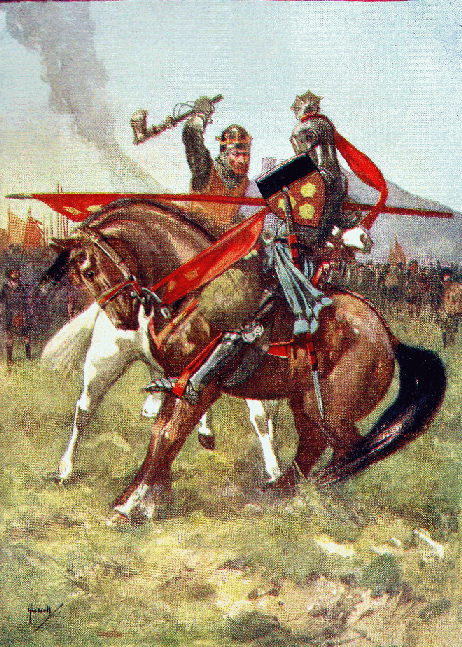 |
One of Bruce's chief enemies in Scotland was Red Comyn, the head of the great Comyn clan. After learning of Comyn's treachery against him, Bruce murdered his nemesis in a fit of passion, and by doing so, permanently broke his tenuous alliance with Edward I, and also became excommunicated. (The murder was done near the altar in a sanctuary, an act of greivous disrespect in the eyes of church.) With absolutely nothing more to lose, Bruce, along with a few loyal cohorts, had himself crowned king of Scotland, in open defiance of Edward I. The first year of Bruce's reign was disastrous. At the Battle of Methuen a great many of Bruce's generals were lost, and soon after several of his brothers were captured and killed. His band of followers was broken up, and he was forced into hiding, nearly alone, since any band of loyal followers who stayed with him would likely betray his location to the English. He finally went into hiding on an island off the Coast of Scotland.
Eventually, Bruce reappeared in his native land of Carrick, but his nobles still feared the English too much to own him as lord. He continued to hide from the English, and face great difficulties until finally his luck turned. Edward I was ill to the point of death and retired from the field. While the nobles all feared Edward I, they had no regard for his son, Edward II, and at once many Scots, who were sympathetic to Bruce, but dared not join forces with him, began to turn off their alliances. When he proved himself successful against the English and a few critical battles, such as Loudon Hill, his support became far wider, and with Edward I on his deathbed, he had little to fear from Edward II. The new king, who was dissipated and preoccupied with other issues, gladly made peace with Bruce, and left Scotland. Over the next several years Bruce regained city after city, castle after castle, without effective opposition. It was not until the Scots threatened Stirling Castle, near the English border, that Edward II was roused to action. Seeing that he was on the verge of losing Scotland altogether, he raised a great army and faced the Scots under Bruce at the Battle of Bannockburn. Although severely outnumbered, the Scots prevailed, and effectively, although not yet officially, secured their independence.
The Scots stayed on the offensive after their victory at Bannockburn, because they did not yet have recognition of their independence from England. Edward Bruce, the brother of Robert tried unsuccessfully to raise a rebellion in Ireland and drive the Scots out. The Scots besieged English castles in Northumbria, and raided English border lands. It was not until Bruce produced a son, by his second wife (he had been separated from his first wife for nearly a decade), that it became clear that his dynasty was secured, and England agreed to make permanent terms of peace, by betrothing the son of Robert Bruce to the young sister of the King of England. Bruce commanded the respect of all of the Scots, and for the rest of his life, ruled as effectively as it was possible to rule such unruly and fractious subjects.
Key events during the life of Robert the Bruce:
| Birth of Robert the Bruce. | |
| Death of the 'Maid of Norway' leaves the Scottish throne vacant. | |
| John Baliol is selected as King of Scotland on condition that he submit to Edward I of England. | |
| Robert swears loyalty to Edward I. of England and fights for him at the Siege of Berkwick. | |
| William Wallace declares for Scottish Independence | |
| Bruce fights for Edward I at the Battle of Falkirk | |
| Bruce is appointed guardian of Scotland along with his enemy, Red Comyn. | |
| Bruce falls in and out of the good graces of Edward I, hoping to be appointed King of Scotland. | |
| Robert Bruce kills Red Comyn, his enemy, and permanently alienates himself from Edward I. | |
| Bruce and his cohorts crown him king of Scotland. | |
| Disastrous Battle of Methuen catches Bruce of his guard. | |
| Bruce and his small band of followers are pursued and attacked. He escapes to an island off the mainland. | |
| Bruce meets and defeats the English at the Battle of Loudon Hill. | |
| Death of Edward I. Bruce soon makes peace with Edward II. | |
| With Edward II preoccupied and absent from Scotland, Bruce regains most of Scotland from the England. | |
| Edward II raises a great army and makes a stand against Bruce at Bannockburn, but is soundly defeated. | |
| Edward Bruce, brother of Robert, raises an army in Ireland to overthrow the British. | |
| Edward is killed in Ireland at the Battle of Faughart. | |
| Bruce besieges the English stronghold of Berkwick, and continues depredations in Northumberland. | |
| David II, a son, is born to Robert Bruce. | |
| Edward II of England is deposed in favor of his son, Edward III. | |
| Death of Robert Bruce. |
| Book Links |
|---|
Other Resources
| Bruce and the Spider in | Fifty Famous Stories Retold by James Baldwin |
| Hunted King in | Fifty Famous People by James Baldwin |
| Robert Bruce and the Black Douglas in | Cambridge Historical Reader—Primary by Cambridge Press |
| Battle of Bannockburn in | Stories from English History by Alfred J. Church |
| Robert Bruce in | Famous Men of the Middle Ages by John H. Haaren |
| Robert Bruce in | Patriots and Tyrants by Marion Florence Lansing |
| Robert Bruce in | Heroes Every Child Should Know by H. W. Mabie |
| Story of King Robert the Bruce and Bohun in | Our Island Story by H. E. Marshall |
| Barbour—'The Bruce,' Beginning of a Struggle in | English Literature for Boys and Girls by H. E. Marshall |
| Bruce—How the Bruce Struck a Blow in | Scotland's Story by Henrietta Elizabeth Marshall |
| Bruce at Bannockburn in | Historical Tales: English by Charles Morris |
| Robert Bruce Wins at Bannockburn and Frees Scotland in | European Hero Stories by Eva March Tappan |
| Bannockburn in | The Boy's Book of Battles by Eric Wood |
Image Links | ||
|---|---|---|
 A drive from the Bruce's spear made the rider fall back dead. in The Story of Robert Bruce |
 The man began to tell lying tales in The Story of Robert Bruce |
 He read to them an old romance in The Story of Robert Bruce |
 One after another the murderers fell before his sword in The Story of Robert Bruce |
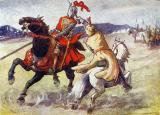 The Bruce drove his battle-axe crashing down on de Bohun's head in The Story of Robert Bruce |
 His royal pet was a lion in The Story of Robert Bruce |
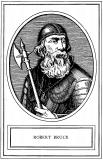 Robert Bruce in Patriots and Tyrants |
 Bruce lifted his battle-axe high in the air, then brought it crashing down upon the helmet of Bohun. in Our Island Story |
 At night, when they gathered round the watch-fires, the King would read stories out of old books in Scotland's Story |
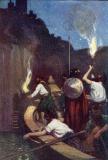 Full of new hope, Bruce sprang to land in Scotland's Story |
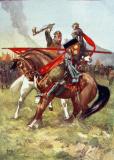 Bruce brought his axe crashing down upon the head of Bohun in Scotland's Story |
|
| Competent and decisive king of England. Reformed government, pacified Wales and Scotland. Ruled 35 years. | |
| Weak and profligate son of Edward I. Lost all his father's holdings in Scotland. | |
| Associate of Robert the Bruce. Fought in wars of Scottish Independence. | |
| John Balliol | Appointed King of Scotland by Edward I on the condition that he surrender Scotland's independence. |
| Commoner who led resistance to Edward I's conquest of Scotland. |